It is another year, and that means it is also Human Trafficking Awareness Month. Taking place every January, this month brings awareness to everyone out on the road that not everyone is here of their own volition. Truck driving can be a fast-paced job, with employees spending hours, days, and even weeks out on the open road. For some it is a freeing and independent lifestyle. For those being trafficked out on the highways of America, though, that world is dark and terrifying. It is important that we take this yearly look to brush up on the information and skills required to locate and help anyone being trafficked.
Human trafficking has been called “modern day slavery,” and rightly so because it involves stealing women, teenagers, boys, and girls from their lives and forcing them into servitude. Trafficking crimes have been shown to affect over twenty-five million people around the world, and, in recent years, it has become a $32 billion industry. While many outside of the industry may not believe that truck drivers would have to deal with this issue, traffickers take their victims to where they can make the most money, and, in today’s world, that means that truck stops, travel centers, rest areas, and more have become popular places to take trafficked women and children. Today, there are groups that are not only advocating for victims of human trafficking, but going to trucking companies, convenience store chains, and even state-run rest stops to train drivers, police officers, and others in recognizing trafficking and how to report it to get those captives out and into safety.
Stopping Trafficking at the Truck Stops
For truck drivers, being solicited for sex at truck stops is not an uncommon occurrence. According to a survey from Truckers Against Trafficking (TAT), the most prevalent method of solicitation is as simple as a knock on the door of a truck when it is sitting idle at a truck stop. Many drivers were raised to believe that prostitution was a choice, but, today, as many truck drivers understand and learn more about human trafficking and what it entails, they are finding that “the world’s oldest career” is just slavery by another name.
As stated above, traffickers are known to frequent highway corridors to conduct their illegal business. This means that truck drivers have been unwittingly put into positions to be able to fight crimes and help trafficked victims. Of course, drivers should be wary and make sure that they don’t do anything to bring harm to captives or themselves, but there are now groups that have taken it upon themselves to train truckers to at least recognize the signs of trafficking. These organizations, such as TAT (Truckers Against Trafficking), have brought together many teachers, including former victims of human trafficking, to tell their stories and share their experiences. Besides valuable training sessions, they also provide contact information for those wishing to report crimes or suspicions and allow the proper authorities to take control.
The fact that so many organizations are banding together to fight human trafficking, signals that the more and more and people are becoming familiar with what is happening, which is the first step to putting an end to this trade. Putting truckers into these training seminars to recognize the signs can only lead to more crimes being reported and more victims being saved.
There are five common signals associated with human trafficking, and these should be conveyed to as many drivers as possible, particularly OTR and Regional drivers, who have the most opportunities to spend the night at a truck stop. While these were posted in our blog story regarding Human Trafficking last year, (see our post from May 15, 2023), it is important to remember them for use in everyone’s travels.
Five Most Common Signs of Trafficking
- Unusual truck stop traffic: Passenger vehicles that start unloading multiple women or children and start sending them to knock on truck cab doors are a sure sign that something is not right.
- Extra CB chatter and/or flashing lights: Traffickers will “advertise” that they have company for commercial drivers on a CB radio. Some of them will also flash their lights to indicate the availability of their captives.
- Unusual security measures: Drivers are told to keep an eye out for any odd or out-of-place security measures. Whether on a car or near a distribution center, if a driver sees barbed wire, exterior cameras, and/or barred and covered windows, it is an indication that there is something amiss.
- Victims are strictly controlled: Captives of traffickers rarely carry any identification on themselves. They might also not speak to anyone for fear of reprisals from their captors. Some may not even know where they are or where they’re supposed to be going. For some, fear of the captor is so strong that the trafficked person feels as if they are being constantly watched, which means they are too scared to report the crimes perpetrated against them.
- Physical signs of captivity: Victims of human trafficking are sometimes “branded” with a tattoo to show ownership. Many are also beaten and bruised, with those marks showing up on victims constantly. Another way to spot captives is by their clothing; while those in control usually wear season-appropriate clothing, the trafficked victims are usually in summer clothes, no matter what the season is. These include short shorts, flip flops, bikini tops, etc.
Conclusion
Organizations like TAT and NATSO (formerly known as the National Association of Truck Stop Operators) have been taking a stand against human trafficking, spending a great deal of time and money to train truck drivers to recognize the signs of this heinous crime. While there are still miles to go, TAT has said that, as of 2020, they have sent out field trainers and explained human trafficking to over a million people, including truck drivers, law enforcement officials, and members of the bus industry. NATSO offers free, online training courses and has been designing and providing training posters on how to understand the different state laws combatting human trafficking. Both of these groups indicate that truck drivers make the best eyes and ears for spotting and reporting potential trafficking victims.
As stated previously, for this author, stressing the importance of stopping human trafficking is the main concern. The first link in the list of resources below is for Truckers Against Trafficking. TAT has everything from toll free hotlines to report crimes, to stickers to place on the cabs of trucks to show victims that they can knock for help instead of sex. Please feel free to reach out to them for more information about procuring trainers or materials to help your drivers feel more ready to face potential human trafficking crimes while they are in the truck.
____________________________________________________________________________
Meaghan Goldberg covers recruitment and digital marketing for Lionzone. A Patterson, GA native, after graduating from both Valdosta State University and Middle Tennessee State University, Meaghan joined Lionzone in 2018 as a digital recruitment strategist before becoming the social media manager.
Resources:
https://truckersagainsttrafficking.org/
https://www.freightwaves.com/news/stay-alert-for-signs-of-sex-trafficking-at-truck-stops
https://www.fleetowner.com/safety/article/21214796/how-trucking-can-combat-human-trafficking
https://www.womenintrucking.org/blog/how-the-trucking-industry-can-help-combat-human-trafficking




